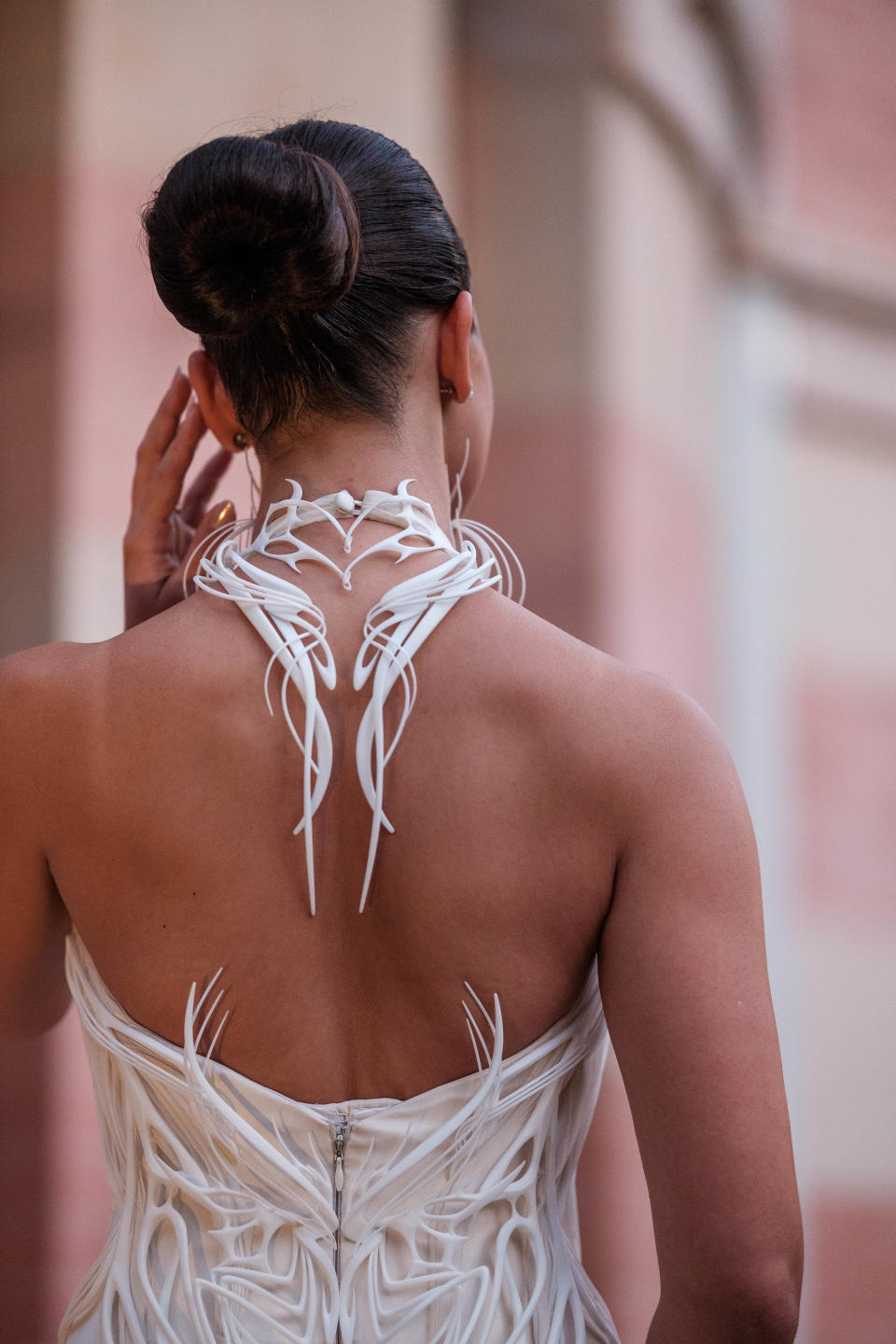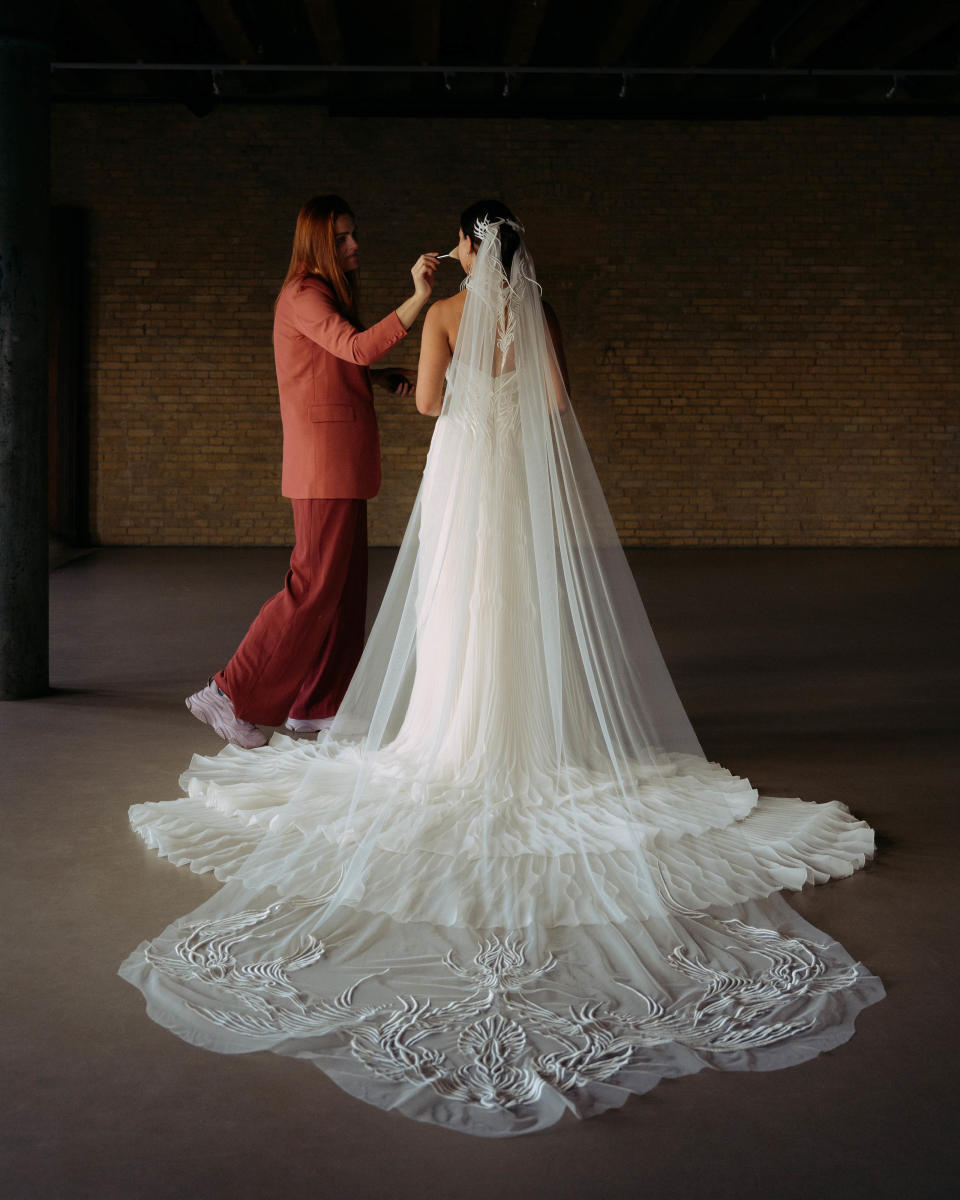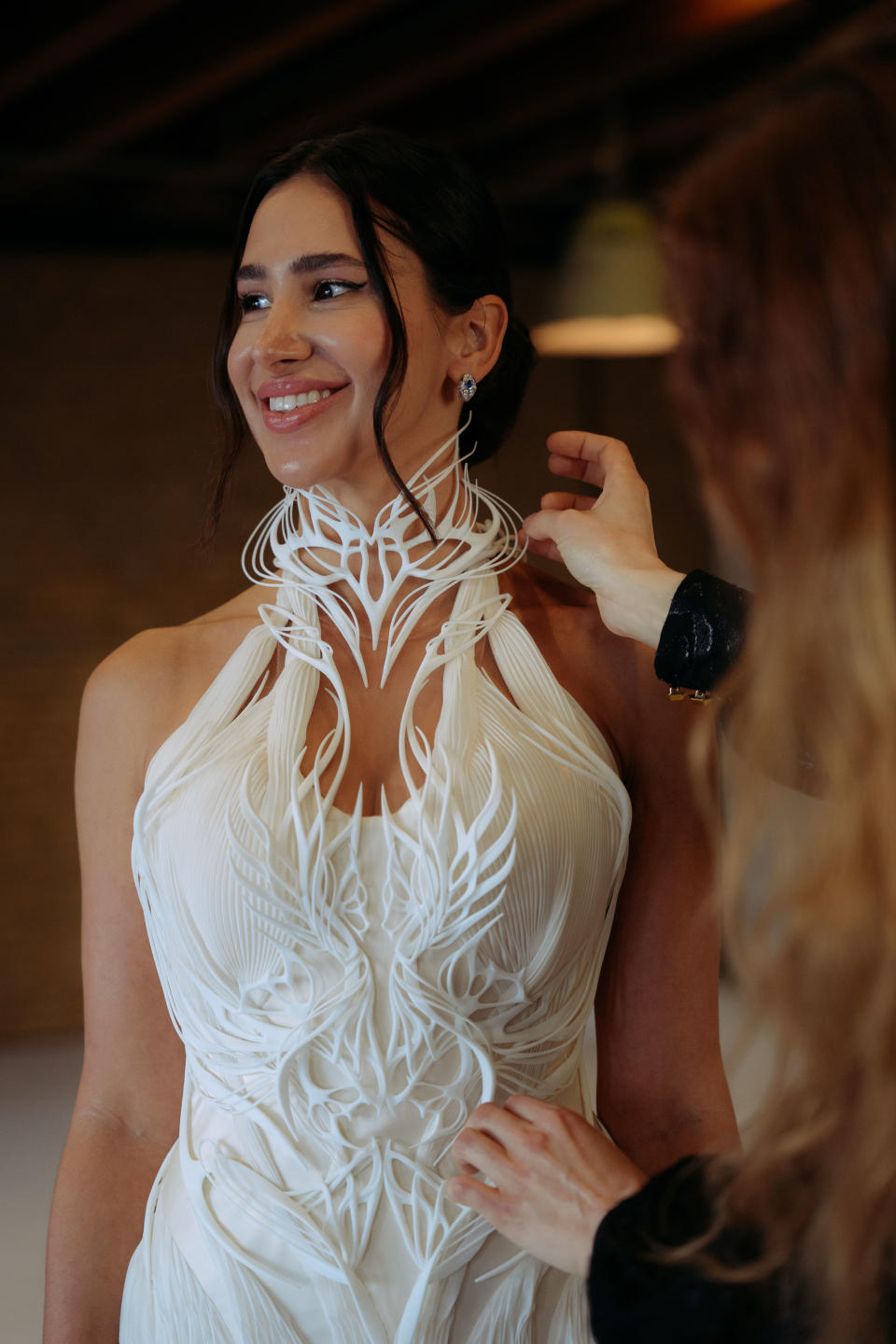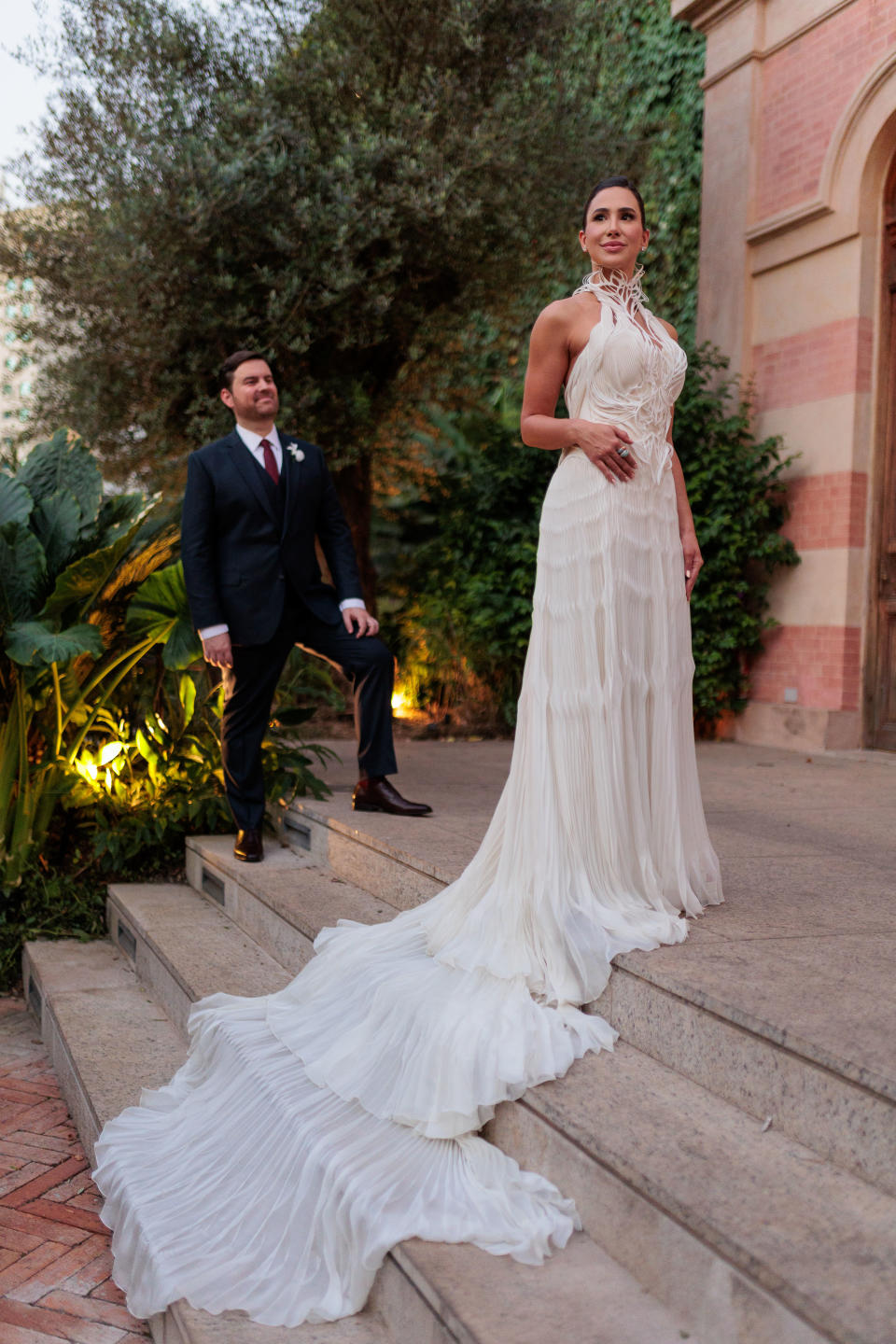How many wedding dresses have a file size?
As far as we know, only one, Brazilian tax lawyer Mariana Pavani, walked down the aisle on May 11 in the high-tech creation of Dutch couturier Iris van Herpen, a pioneer of 3D printed garments whose first design from 2010, a stiff creation reminiscent of overlapping shells was recently on display at the Musée des Arts Décoratifs in Paris.
More from WWD
In contrast, Pavani’s wedding gown has an otherworldly delicacy, with the swarm of futuristic frost over the bodice and neck giving a solid look that belies its fluidity and durability.
“There are no seams. You couldn’t do this with a typical pattern,” says Van Herpen, whose Amsterdam studio spent 600 hours realizing the design, preceded by a lot of tinkering with ZBrush, a digital sculpting software.
“This was really a dream project for me because 3D printed fashion can be found in museums and on catwalks, but having someone wear it on the most special day of her life, I think it’s really something else,” she said .
“I really wanted a statement dress, something unique,” Pavani said via Zoom from her home in São Paulo about a week before the ceremony. “From the start, I hoped that the dress would integrate 3D printing into the design.”


The process started with a 3D body scan of Pavani, required several personal adjustments to the hand-pleated base dress, and then a painstaking combination of the delicate fabric and the 3D printed elements, which was done in a specialized factory in Paris.
The file size for the 3D design was 216.7 MB and printing took 41 hours, according to Van Herpen.
She noted that several tests had been carried out on the 3D printed elements and on the intricate pleats, the pattern of which had to match the design of the bodice. “So you have the sculptural elements, but also the fluidity, the movement. And that’s the dichotomy that I really love,” says the designer, who had a dance background before becoming a couturier.
Despite all the high-tech elements and experiments, the end result stirred powerful human emotions.
“It was one of those moments where she started crying when she put the dress on, and it was so magical,” said Van Herpen, sighing in delight and raising her eyes to the sky.
“It was difficult to hold back my tears,” Pavani admitted. “We achieved everything I hoped for… The final design gives me a powerful and feminine feeling, a very unique and special look.”
Pavani also praised Van Herpen’s “great team” for making her feel “welcome and part of the creative process. There was also a lot of work to get the final design to fit and feel right on my body. They thought of everything: the way the dress fits me, the way the dress moves and feels, and even the length of the veil in relation to the chapel we are getting married in.”
Pavani said her fiancé, composer and art collector Roberto Toscano, introduced her to Van Herpen’s work and arranged tickets for her fall 2022 fashion show in Paris.
“I just thought it was breathtaking: the movement of the dresses, the way the collection flowed, and Iris’ love for nature really spoke to me,” she recalls. “We immediately started talking to the team to see if a wedding dress could be made.”


Van Herpen described a strong complicity with Pavani, who shares her love for nature, art and pushing boundaries.
“I wanted to bring femininity, but with an ultra-modern atmosphere, because she is someone who is not ordinary at all. She is really not afraid to express herself,” says the designer enthusiastically about Pavani. “We both believe that fashion is a form of art. And so she really dares to express herself and embody that femininity, but also with the influences of new technology.”
Van Herpen, who combines traditional couture techniques such as pleating, draping and beading with high-tech elements such as silicon casting and laser cutting, sees both as central to her brand DNA.
She was dazzled by the possibilities of the Parisian printer, which she only discovered a year ago. “The quality of the flexible material is so, so good,” she marveled at the nylon polymer known as PA 12. “She can sit in it, she can basically put anything in it without it becoming less flexible over time .”
There are still many misconceptions about 3D printing in fashion, and many consider it technically out of bounds.
“It is a very complicated process. Yes, you have to get comfortable with it, but once you get the hang of it, I don’t think it’s much harder than some of the more traditional ways of working,” says Van Herpen.
As for the continued belief that 3D printed fashion is unwearable: “That’s history, because with the materials and the flexibility you have today, it’s super comfortable.
“It’s exactly where I hoped it would be back then,” she said – “back then” in 2010 when she realized her first 3D-printed garment. She said it took scientists many years of innovation and “stress testing” to overcome “limitations on the sustainability of flexibility.”
Pavani’s dress also does not require any exceptional care or treatment. “The cleaning is just like any expensive wedding look: you can’t put it in the washing machine, but it’s fine for dry cleaning. And for storage, you can just hang it on the hanger. It is so light,” says Van Herpen.
According to Van Herpen, 3D printing creates “a lot of freedom” in design, explaining that the “look you see on this bride is not something we could create in any other way. The sculptural complexity of these files makes it impossible for us to make this by hand. You couldn’t do that with any form of pattern making.
“I also love the seamlessness and therefore the smoothness, the cleanliness of it is something I really love,” she added. “I think a lot of people still feel a little scared by the process [of 3D-printing] because it is different, but it gives you a lot of freedom once you own it.”


That said, “you have to keep your eyes open to what’s happening in different parts of the world because 3D printing is truly global,” she said.
Considering that her wedding dress goes where no dress has gone before, Pavani said she would never expect everyone to appreciate it as much as she does.
“Like all art, there will be different opinions about the dress. I accept that,” she said. “But for me, the 3D printed structure that attaches to the neck is very symbolic. The shape of the neck element is reminiscent of the eyes of an owl, which in the Brazilian religion of Candomblé is usually associated with wisdom. Both spirituality and nature are areas in which I am very interested.”
Pavani even considers the dress as a work of art that she wants to display in her apartment.
“Both Roberto and I are very proud that Iris had my wedding dress designed,” she said. “It’s a masterpiece.”


The best of WWD